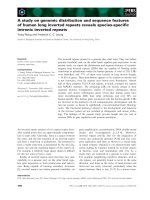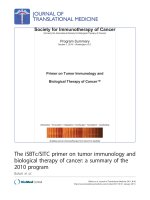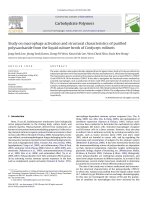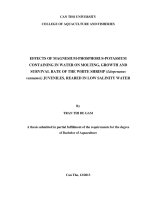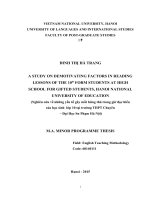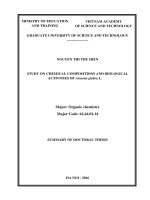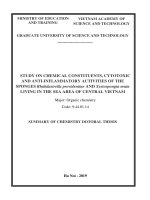Study on chemical constituents and biological activities of the lichen parmotrema Praesorediosum(NYL ) hale(parmeliaceaf)
Bạn đang xem bản rút gọn của tài liệu. Xem và tải ngay bản đầy đủ của tài liệu tại đây (16.44 MB, 293 trang )
VIETNAM NATIONAL UNIVERSITY - HO CHI MINH CITY
UNIVERSITY OF SCIENCE
HUYNH BUI LINH CHI
STUDY ON CHEMICAL
CONSTITUENTS AND BIOLOGICAL
ACTIVITIES OF THE LICHEN
PARMOTREMA PRAESOREDIOSUM
(NYL.) HALE
(PARMELIACEAE)
DOCTORAL THESIS IN CHEMISTRY
Ho Chi Minh City, 2014
VIETNAM NATIONAL UNIVERSITY - HO CHI MINH CITY
UNIVERSITY OF SCIENCE
HUYNH BUI LINH CHI
STUDY ON CHEMICAL CONSTITUENTS AND
BIOLOGICAL ACTIVITIES OF THE LICHEN
PARMOTREMA PRAESOREDIOSUM (NYL.) HALE
(PARMELIACEAE)
Subject: Organic Chemistry
Code number: 62 44 27 01
Examination Board:
Prof. Dr. Nguyen Minh Duc
(1st Reviewer)
Assoc. Prof. Dr. Tran Cong Luan
(2nd Reviewer)
Assoc. Prof. Dr. Pham Dinh Hung
(3rd Reviewer)
Assoc. Prof. Dr. Le Thi Hong Nhan
(1st Independent Reviewer)
Dr. Le Tien Dung
(2nd Independent Reviewer)
SUPERVISORS: PROF. DR. NGUYEN KIM PHI PHUNG
PROF. DR. TAKAO TANAHASHI
Ho Chi Minh City, 2014
i
SOCIALIST REPUBLIC OF VIETNAM
INDEPENDENCE-FREEDOM-HAPPINESS
DECLARATION
The work presented in this thesis was completed in the period of November
2009 to November 2013 under the co-supervision of Professor Nguyen Kim Phi
Phung of the University of Science, Vietnam National University, Ho Chi Minh
City, Vietnam and Professor Takao Tanahashi of the Kobe Pharmaceutical
University, Japan.
In compliance with the university regulations, I declare that:
1. Except where due acknowledgement has been made, the work is that of the
author alone;
2. The work has not been submitted previously, in whole or in part, to qualify for
any other academic award;
3. The content of the thesis is the result of the work which has been carried out
since the official commencement date of the approved doctoral research program;
4. Ethics procedures and guidelines have been followed.
Ho Chi Minh City, Sept 30, 2014
PhD student
HUYNH BUI LINH CHI
ii
ACKNOWLEDGEMENTS
There are many individuals without whom the work described in this thesis
might not have been possible, and to whom I am greatly indebted.
Firstly, I wish to thank my supervisor, Prof. Dr. Nguyen Kim Phi Phung for
her knowledge, support, and guidance, hundreds of meetings/emails and for always
keeping me on my toes, from the very beginning to the very end of my PhD.
I would also like to acknowledge my second supervisor, Prof. Dr. Takao
Tanahashi for his guidance, patience and who has taught me the true spirit of
research. I am deeply indebted to Dr. Yukiko Takenaka at Kobe Pharmaceutical
University, Japan for her teachings, kindness, helpful suggestion and valuable
advice in this research.
I would also like to express my sincere thanks to PhD Vo Thi Phi Giao at
University of Science, Vietnam National University, Ho Chi Minh City and Dr.
Harrie J. M. Sipman, Botanic Garden and Botany Museum Berlin-Dahlem, Freie
University, Berlin, Germany for his expertise in the identification of lichen.
I am very grateful to thank Prof. Dr. Shigeki Yamamoto, Prof. Dr. Hitoshi
Watarai at Osaka University, Japan and PhD. Do Thi My Lien for giving up their
precious time to help me with CD spectra, sample preparation and proof reading of
some isolated compounds of the thesis.
A special thanks to Dr. Le Hoang Duy for his helpful assistance and
friendship during my work at Kobe Pharmaceutical University, Japan.
I would like to acknowledge the encouragement, insightful comments of the
rest of examination board: Prof. Dr. Nguyen Cong Hao, Prof. Dr. Nguyen Minh
Duc, Assoc. Prof. Dr. Tran Cong Luan, Assoc. Prof. Dr. Pham Dinh Hung, Assoc.
Prof. Dr. Nguyen Trung Nhan, Dr. Pham Nguyen Kim Tuyen and Dr. Le Tien
Dung.
iii
Similarly, I would also like to thank my teachers, friends and students in the
Department of Organic Chemistry, Faculty of Chemistry, University of Science,
Vietnam National University-Ho Chi Minh City.
Most importantly, I would like to thank my husband, for being the most
patient and supportive witness to my academic journey over the past four years.
Without his support, love and encouragement, this study would not have been
possible.
Finally, I would like to thank my parents for believing in me and for being
proud of me. Their unconditional love and support has given me the strength and
courage while I am far from home.
THANK YOU
iv
TABLE OF CONTENTS
DECLARATION ....................................................................................................... i
ACKNOWLEDGEMENTS ...................................................................................... ii
TABLE OF CONTENTS ......................................................................................... iv
LIST OF ABBREVIATIONS.................................................................................. vi
LIST OF TABLES ................................................................................................... xi
LIST OF FIGURES ............................................................................................... xiii
LIST OF APPENDICES......................................................................................... xv
INTRODUCTION ..................................................................................................... 1
CHAPTER 1: LITERATURE REVIEW ................................................................ 3
1.1. GENERIC DESCRIPTION ............................................................................... 3
1.1.1. The lichen .......................................................................................................... 3
1.1.2. Parmotrema praesorediosum (Nyl.) Hale ......................................................... 4
1.2. CHEMICAL STUDIES ON THE LICHEN GENUS PARMOTREMA ........... 6
1.2.1. Lichen secondary metabolites ........................................................................... 6
1.2.2. Chemical studies on the lichen genus Parmotrema .......................................... 8
1.3. BIOLOGICAL ACTIVITIES ......................................................................... 14
1.3.1. The biological significance of lichen metabolites ........................................... 14
1.3.2. The biological significance of the lichen Parmotrema ................................... 15
CHAPTER 2: EXPERIMENTAL ......................................................................... 20
2.1. MATERIALS AND ANALYSIS METHODS ............................................... 20
2.2. LICHEN MATERIALS .................................................................................. 22
v
2.3. EXTRACTION AND ISOLATION PROCEDURES .................................... 22
2.3.1. Isolating compounds from the methanol precipitate ....................................... 22
2.3.2. Isolating compounds from the petroleum ether E1 extract ............................ 23
2.3.3. Isolating compounds from the petroleum ether E2 extract ............................ 23
2.3.4. Isolating compounds from the chloroform extract ......................................... 24
2.4. PREPARATION OF SOME DERIVATIVES ................................................ 28
2.4.1. Esterification of PRAES-C2 ............................................................................ 28
2.4.2. Methylation of PRAES-C25 ............................................................................ 29
2.5. BIOLOGICAL ASSAY .................................................................................. 29
2.5.1. Cytotoxicity ..................................................................................................... 29
2.5.2. In vitro acetylcholinesterase (AChE) inhibition assay .................................... 30
CHAPTER 3: RESULTS AND DISSCUSSION .................................................. 32
3.1. CHEMICAL STRUCTURE ELUCIDATION .............................................. 32
3.1.1. Chemical structure of aliphatic acids .............................................................. 33
3.1.1.1. Structure elucidation of compound PRAES-C1........................................... 33
3.1.1.2. Structure elucidation of compound PRAES-E14 ......................................... 34
3.1.1.3. Structure elucidation of compound PRAES-C10 ........................................ 35
3.1.1.4. Structure elucidation of compound PRAES-C11 ........................................ 39
3.1.1.5. Structure elucidation of compound PRAES-E19 ......................................... 40
3.1.1.6. Structure elucidation of compound PRAES-C2........................................... 41
3.1.2. Chemical structure of mononuclear phenolic compounds .............................. 45
3.1.2.1. Structure elucidation of compound PRAES-T1 ........................................... 45
3.1.2.2. Structure elucidation of compound PRAES-E1 ........................................... 46
vi
3.1.2.3. Structure elucidation of compound PRAES-T2 ........................................... 48
3.1.2.4. Structure elucidation of compound PRAES-E11 ......................................... 49
3.1.2.5. Structure elucidation of compound PRAES-T4 ........................................... 50
3.1.2.6. Structure elucidation of compound PRAES-T6 ........................................... 50
3.1.2.7. Structure elucidation of compound PRAES-E2 ........................................... 51
3.1.2.8. Structure elucidation of compound PRAES-C22 ........................................ 53
3.1.2.9. Structure elucidation of compound PRAES-C23 ........................................ 55
3.1.2.10. Structure elucidation of compound PRAES-C24 ...................................... 56
3.1.2.11. Structure elucidation of compound PRAES-C25 ...................................... 59
3.1.2.12. Structure elucidation of compound PRAES-C26 ...................................... 63
3.1.3. Chemical structure of depsides ....................................................................... 66
3.1.3.1. Structure elucidation of compound PRAES-T3 ........................................... 66
3.1.3.2. Structure elucidation of compound PRAES-C7........................................... 67
3.1.3.3. Structure elucidation of compound PRAES-E18 ......................................... 69
3.1.4. Chemical structure of depsidones ................................................................... 70
3.1.4.1. Structure elucidation of compound PRAES-C14 ........................................ 70
3.1.4.2. Structure elucidation of compound PRAES-C12 ........................................ 73
3.1.5. Chemical structure of diphenyl ethers ............................................................ 74
3.1.5.1. Structure elucidation of compound PRAES-C5........................................... 74
3.1.5.2. Structure elucidation of compound PRAES-C15 ........................................ 77
3.1.5.3. Structure elucidation of compound PRAES-C16 ........................................ 79
3.1.5.4. Structure elucidation of compound PRAES-C20 ........................................ 84
3.1.5.5. Structure elucidation of compound PRAES-C18 ........................................ 86
vii
3.1.5.6. Structure elucidation of compound PRAES-C3........................................... 89
3.1.5.7. Structure elucidation of compound PRAES-C4........................................... 91
3.1.5.8. Structure elucidation of compound PRAES-C21 ........................................ 93
3.1.6. Chemical structure of dibenzofurans .............................................................. 97
3.1.6.1. Structure elucidation of compound PRAES-E5 ........................................... 97
3.1.6.2. Structure elucidation of compound PRAES-E3 ........................................... 99
3.1.6.3. Structure elucidation of compound PRAES-C8......................................... 100
3.1.7. Chemical structure of xanthones ................................................................... 103
3.1.7.1. Structure elucidation of compound PRAES-C27 ...................................... 103
3.1.7.2. Structure elucidation of compound PRAES-C28 ...................................... 108
3.1.8. Chemical structure of triterpenoids ............................................................... 111
3.1.8.1. Structure elucidation of compound PRAES-E17 ....................................... 111
3.1.8.2. Structure elucidation of compound PRAES-E6 ......................................... 112
3.1.8.3. Structure elucidation of compound PRAES-E13 ....................................... 113
3.1.9. Chemical structure of a macrocylic compound............................................. 117
3.1.9.1. Structure elucidation of compound PRAES-E15 ....................................... 117
3.2. BIOLOGICAL ASSAY ................................................................................ 120
3.2.1. Cytotoxicity activitivy................................................................................... 120
3.2.2. Acetylcholinesterase inhibitory activity ....................................................... 121
CHAPTER 4: CONCLUSION ............................................................................. 124
4.1. CONSTITUENTS OF PARMOTREMA PRAESOREDIOSUM ................... 124
4.2. BIOLOGICAL ASSAY ................................................................................ 132
FUTURE OUTLOOK ........................................................................................... 133
viii
LIST OF PUBLICATIONS .................................................................................. 134
REFERENCES ...................................................................................................... 135
APPENDICES ....................................................................................................... 145
ix
LIST OF ABBREVIATIONS
1D
One dimensional
2D
Two dimensional
Ac
Acetone
AcOH
Acetic acid
br
Broad
C
Chloroform
calcd
Calculated
CC
Column chromatography
CD
Circular dichroism
COSY
Homonuclear shift correlation spectroscopy
CPCM
Conductor-like polarized continuum model
d
Doublet
dd
Doublet of doublets
DEPT
Distortionless enhancement by polarisation transfer
DMSO
Dimethyl sulfoxide
EA
Ethyl acetate
EI-MS
Electron-impact ionization mass spectrum
EtOH
Ethanol
H
n-Hexane
HMBC
Heteronuclear multiple bond correlation spectroscopy
HPLC
High performance liquid chromatography
HR-EIMS
High resolution electron-impact ionization mass spectrum
HR-ESIMS
High resolution electrospray ionization mass spectrum
x
HSQC
Heteronuclear single quantum correlation spectroscopy
IR
Infrared spectrophotometry
m
Multiplet
M
Methanol
MeOH
Methanol
min
Minutes
MS
Mass spectrum
NMR
Nuclear magnetic resonance
NOESY
Nuclear overhauser enhancement spectroscopy
P
Petroleum ether
ppm
Parts per million (chemical shift value)
pre TLC
Preparative thin-layer chromatography
q
Quartet
quint
Quintet
ROESY
Rotating-frame overhauser enhancement spectroscopy
s
Singlet
sext
Sextet
t
Triplet
TD-DFT
Time dependent density functional theory
TLC
Thin-layer chromatography
TMS
Tetramethylsilane
UV
Ultraviolet
xi
LIST OF TABLES
Table 1.1.
In vitro biological activities of the lichen genus Parmotrema
17
Table 3.1.
Isolated compounds from Parmotrema praesorediosum
32
Table 3.2.
1
38
Table 3.3.
13
Table 3.4.
NMR data of PRAES-T1, PRAES-E1, PRAES-T2
47
Table 3.5.
NMR data of PRAES-E11, PRAES-T4, PRAES-T6, PRAES-E2
52
Table 3.6.
NMR data of PRAES-C22, PRAES-C23, PRAES-C24
58
Table 3.7.
NMR data of PRAES-C25, PRAES-C25M, PRAES-C26
65
Table 3.8.
NMR data of PRAES-T3, PRAES-C7, PRAES-C9, PRAES-E18
68
Table 3.9.
NMR data of PRAES-C14 and PRAES-C12
72
Table 3.10.
1
H NMR data of PRAES-C5 and Lecanorol
76
Table 3.11.
1
H NMR data of PRAES-C15, PRAES-C16, PRAES-C20,
H NMR of aliphatic compounds
C NMR of aliphatic compounds
PRAES-C18, PRAES-C3 and PRAES-C4
Table 3.12
13
39
82
C NMR data of PRAES-C15, PRAES-C16, PRAES-C20,
PRAES-C18, PRAES-C3 and PRAES-C4
83
Table 3.13. NMR data of PRAES-C21
96
Table 3.14. NMR data of PRAES-E5 and PRAES-E3 (CDCl3)
98
Table 3.15. NMR data of PRAES-C8, PRAES-E5 and Usimine A
102
Table 3.16. NMR data of PRAES-C27, Blennolide G, Blennolide B and
Chromone lactone (CDCl3)
Table 3.17. NMR data of PRAES-C27 and PRAES-C28 (CDCl3)
106
110
xii
Table 3.18. NMR data of PRAES-E17, PRAES-E6, PRAES-E13 and 1β,3βDiacetoxyhopan-22-ol
Table 3.19. NMR data of PRAES-E15
115
120
Table 3.20. % Inhibition of cytotoxic activity against three cancer cell lines of
isolated compounds
122
Table 3.21. IC50 value of cytotoxic activity against three cancer cell lines of
isolated compounds
122
Table 3.22. Acetylcholinesterase inhibition of some extracts and isolated
compounds
123
xiii
LIST OF FIGURES
Figure 1.1. Types of the lichen
3
Figure 1.2. Parmotrema praesorediosum (Nyl.) Hale (Parmeliaceae)
5
Figure 1.3. Biosynthetic pathways of the major groups of lichen substances
7
Figure 2.1: Isolation of compounds from the prepicitate and petroleum ether
extracts of Parmotrema praesorediosum (Nyl.) Hale
26
Figure 2.2: Isolation of compounds from the chloroform extract of Parmotrema
praesorediosum (Nyl.) Hale
27
Figure 3.1. HMBC correlations of PRAES-C1 and PRAES-E14
36
Figure 3.2. HMBC correlations of PRAES-C10
37
Figure 3.3. HMBC correlations of PRAES-E19
41
Figure 3.4. HMBC correlations of PRAES-C2
42
Figure 3.5. Comparison of experimental CD spectrum of PRAES-C2Me and
theoretical calculated one.
44
Figure 3.6. CD spectra of isolated aliphatic compounds
45
Figure 3.7. HMBC correlations of PRAES-E1 and PRAES-T2
48
Figure 3.8. HMBC correlations of PRAES-E11, PRAES-T4 and PRAES-E2
52
Figure 3.9. HMBC and NOESY correlations of PRAES-C22
54
Figure 3.10. HMBC and NOESY correlations of PRAES-C23
56
Figure 3.11. HMBC and NOESY correlations of PRAES-C24
57
Figure 3.12. COSY, HMBC and NOESY correlations of PRAES-C25M
61
Figure 3.13. Mechanism for the methylation of PRAES-C25
62
Figure 3.14. HMBC and NOESY correlations of PRAES-C25 and PRAES-C26 63
xiv
Figure 3.15. HMBC correlations of PRAES-C9 and PRAES-C7
67
Figure 3.16. COSY and HMBC correlations of PRAES-E18
70
Figure 3.17. HMBC correlations of PRAES-C12
73
Figure 3.18. HMBC correlations of PRAES-C5
75
Figure 3.19. HMBC and NOESY correlations of PRAES-C15
78
Figure 3.20. HMBC and ROESY correlations of PRAES-C16
80
Figure 3.21. HMBC and ROESY correlations of PRAES-C20
85
Figure 3.22. 1H NMR data of PRAES-C18 and diphenyl ether
87
Figure 3.23. HMBC and ROESY correlations of PRAES-C18
88
Figure 3.24. HMBC correlations of PRAES-C3
90
Figure 3.25. HMBC correlations of PRAES-C4
93
Figure 3.26. HMBC correlations of PRAES-C21
94
Figure 3.27. ROESY correlations of PRAES-C21
95
Figure 3.28. HMBC correlations of PRAES-E5
97
Figure 3.29. HMBC correlations of PRAES-E3
99
Figure 3.30. HMBC correlations of PRAES-C8
101
Figure 3.31. The structure of Usimine A
102
Figure 3.32. COSY, HMBC and ROESY correlations of PRAES-C27
104
Figure 3.33. ROESY correlations of PRAES-C28
109
Figure 3.34. COSY and HMBC correlations of PRAES-C28
111
Figure 3.35. HMBC correlations of PRAES-E17
112
Figure 3.36. HMBC correlations of PRAES-E13
114
Figure 3.37. COSY and HMBC correlations of PRAES-E15
118
xv
LIST OF APPENDICES
Appendices 1-7: IR, MS and NMR spectra of PRAES-C1
146
Appendices 8-15: IR, MS and NMR spectra of PRAES-E14
149
Appendices 16-21: MS and NMR spectra of PRAES-C10
153
Appendices 22-26: MS and NMR spectra of PRAES-C11
156
Appendices 27-33: IR, MS and NMR spectra of PRAES-E19
159
Appendices 34-40: IR, MS and NMR spectra of PRAES-C2
162
Appendices 41-44: NMR spectra of PRAES-T1
166
Appendices 45-49: MS and NMR spectra of PRAES-E1
168
Appendices 50-54: NMR spectra of PRAES-T2
170
Appendices 55-58: NMR spectra of PRAES-E11
173
Appendices 59-62: NMR spectra of PRAES-T4
175
Appendices 63-66: MS and NMR spectra of PRAES-T6
177
Appendices 67-70: NMR spectra of PRAES-E2
179
Appendices 71-78: IR, MS and NMR spectra of PRAES-C22
181
Appendices 79-86: IR, MS and NMR spectra of PRAES-C23
185
Appendices 87-94: IR, MS and NMR spectra of PRAES-C24
189
Appendices 95-97: MS and NMR spectra of PRAES-C25
193
Appendices 98-106: IR, MS and NMR spectra of PRAES-C25M
194
Appendices 107-114: IR, MS and NMR spectra of PRAES-C26
199
Appendices 115-119: NMR spectra of PRAES-T3
203
Appendices 120-124: NMR spectra of PRAES-C7
205
xvi
Appendices 125-131: MS and NMR spectra of PRAES-E18
208
Appendices 132-136: MS and NMR spectra of PRAES-C14
211
Appendices 137-141: NMR spectra of PRAES-C12
214
Appendices 142-147: MS and NMR spectra of PRAES-C5
216
Appendices 148-155: IR, MS and NMR spectra of PRAES-C15
219
Appendices 156-163: IR, MS and NMR spectra of PRAES-C16
223
Appendices 164-172: IR, MS and NMR spectra of PRAES-C20
227
Appendices 173-180: IR, MS and NMR spectra of PRAES-C18
232
Appendices 181-186: MS and NMR spectra of PRAES-C3
236
Appendices 187-192: MS and NMR spectra of PRAES-C4
239
Appendices 193-200: IR, MS and NMR spectra of PRAES-C21
242
Appendices 201-204: NMR spectra of PRAES-E5
246
Appendices 205-207: NMR spectra of PRAES-E3
248
Appendices 208-213: MS and NMR spectra of PRAES-C8
249
Appendices 214-222: IR, MS and NMR spectra of PRAES-C27
252
Appendices 223-231: IR, MS and NMR spectra of PRAES-C28
256
Appendices 232-235: NMR spectra of PRAES-E17
261
Appendices 236-237: NMR spectra of PRAES-E6
263
Appendices 238-244: MS and NMR spectra of PRAES-E13
264
Appendices 245-259: MS and NMR spectra of PRAES-E15
268
INTRODUCTION
Lichens are by definition symbiotic organisms composed of a fungal partner
(mycobiont) and one or more photosynthetic partners (photobiont/s). The photobiont
can be either a green alga or a cyanobacterium. Morphologically lichens can be
classified into three major groups. They are foliose, fruticose and crustose. Growing
rates of lichens are extremely slow. More than twenty thousand species of lichens
have been found. They can tolerate very drastic weather conditions and are resistant
to insects and other microbial attacks. Lichens produce a variety of secondary
compounds. They play an important role in protection and maintenance of the
symbiotic relationship [1].
Many lichen secondary metabolites exhibited antibiotic, antitumour,
antimutagenic, allergenic, antifungal, antiviral, enzyme inhibitory and plant growth
inhibitory properties [5, 12]. In 2007, Balaji. P. et al. [3] indicated that
dichloromethane, ethyl acetate and acetone methanol extracts of Parmotrema
praesorediosum showed antimicrobial activity against ten bacterial (Gram + and -)
(Bacillus cereus, Corynebacterium diptheriae, Proteus mirabilis, Proteus vulgari,
Pseudomonas aeruginosa, Salmonella typhi, Shigella flexnerii, Staphylococcus
aureus, Streptococcus pyogenes and Vibrio cholera) and one fungal Candida albicans
by using standard dics diffusion method. This lichen could therefore be a potential
source in the search for pharmaceutical useful chemicals.
The primary goal of the present work was to isolate secondary metabolites
on the lichen Parmotrema praesorediosum (Nyl.) Hale. The chemical structure of
isolated compounds was characterized by spectroscopic methods (1D-, 2D-NMR,
HRMS, CD). Finally, the purified substances from this source were assayed for the
cytotoxic activities against three cell lines: MCF-7 (breast cancer cell line), HeLa
(cervical cancer cell line) and NCI-H460 (human lung cancer cell line) by
1
sulforhodamine B colorimetric assay method (SRB assay) [56] and the inhibition
against acetylcholinesterase in vitro.
Based on spectroscopic evidence and their physical properties, the chemical
structures were attributed for be forty compounds, including six aliphatic acids,
twelve mononuclear phenolic acids, three depsides, two depsidones, eight diphenyl
ethers, three dibenzofurans, two xanthones, three triterpenoids and a macrocyclic
compound. The latter twenty two compounds appeared to be new and among
eighteen known compounds, twelve compounds were known for the first time from
the genus Parmotrema. These results pointed out that the Vietnamese lichens could
be new sources of bioactive compounds with novel skeletons
2
CHAPTER 1
LITERATURE REVIEW
1.1. GENERIC DESCRIPTION
1.1.1. The lichen
Lichens are by definition symbiotic organisms, usually composed of a fungal
which is most often either a green alga or cyanobacterium. The photobionts produce
carbohydrates by photosynthesis for themselves and for their dominant fungal
counterparts (mycobionts), which provide physical protection, water and mineral
supply [73]. Overall the lichen symbiosis is a very successful one, as lichens are
found in almost all terrestrial habitats from the tropics and deserts to polar regions.
As the results of the relationship, both the fungus and algae/cyanobacterium
partners, which mostly thrive in relatively moist and moderate environments in free
living form, have expanded into many extreme terrestrial habitats, where they
would separately be rare or non-existent [52]. On the basis of their forms and
habitats, lichens are traditionally divided into three main morphological groups:
crustose, foliose and fructicose (Figure 1.1) [42].
Crustose
Foliose
Figure 1.1. Types of the lichen
3
Fructicose
The lichen symbiosis is different other than kinds of symbiosis because the
lichen takes on a new body shape that neither the fungus nor the alga had
independently [73]. About 17,000 different lichen taxa, including 16,750 lichenized
Ascomycetes, 200 Deuteromycetes, and 50 Basidiomycetes have been described
world-wide. A thallus consists of a cortex and a medulla, both made up of fungal
tissue and a photobiont layer in which the alga and cyanobacterial cells are
endeveloped by fungal hyphae.
1.1.2. Parmotrema praesorediosum (Nyl.) Hale
The Parmeliaceae is a large and diverse family of Lecanoromycetes. With
over 2000 species in roughly 87 genera, it is regarded as the largest family of lichen
forming fungi [39]. The most speciose genera in the family are the well-known
groups: Xanthoparmelia (800+ species), Usnea (500+ species), Parmotrema (350+
species), and Hypotrachyna (190+ species) [39]. Nearly all members of the family
have a symbiotic association with a green alga (most often Trebouxia spp., but
Asterochloris spp. are known to associate with some species) [73]. The majority of
Parmeliaceae species have a foliose, fruticose, or subfruticose growth form. The
family has a cosmopolitan distribution, and can be found in a wide range of habitats
and climatic regions [73]. Members of the Parmeliaceae can be found in most
terrestrial environments
Parmotrema A. Massal. (previously known as Parmelia s.lat.) is one of the
largest genera of parmelioid core in the family Parmeliaceae [39]. The Parmotrema
genus is characterized by foliose thalli forming short and broad, rarely elongated,
often ciliate lobes, a pored epicortex, cylindrical conidia and the intermediate type
of lichenan between Cetraria-type lichenan and Xanthoparmelia-type lichenan. The
lower surface of the thallus is white to black, usually sparingly rhizinate with a wide
bare marginal zone, sometimes irregularly rhizinate or finely short-rhizinate with
scattered much longer rhizines mixed without an erhizinate margin or with a very
narrow one [72].
4
The upper surface
The lower surface
Figure 1.2. Parmotrema praesorediosum (Nyl.) Hale (Parmeliaceae)
Scientific name:
Parmotrema praesorediosum (Nyl.) Hale
Parmelia praesorediosa Nyl.
Family: Parmeliaceae
Morphography: Thallus foliose, adnate to the substratum, 3~10 cm across.
Lobes round, 4~10 mm wide; margins entire or crenate, eciliate, sorediate. Upper
surface pale grey to grey, smooth, dull, emaculate, weakly rugose, lacking isidia,
sorediate. Soralia marginal, linear to crescent shaped, granular. Medulla white.
Lower surface black, minutely rugose, with shiny, mottled, ivory or brown,
erhizinate marginal zone. Rhizines sparse, simple, short. Apothecia and pycnidia is
not seen [49].
Spotest: Cortex K+ (yellow), C−, KC−, P−; medulla K−, C−, KC−, P−
TLC: atranorin, chloroatranorin, fatty acids (protopraesorediosic acid,
praesorediosic acid).
5
1.2. CHEMICAL STUDIES ON THE LICHEN GENUS PARMOTREMA
1.2.1. Lichen secondary metabolites
Primary metabolites of lichens, which are intracellular, are proteins, amino
acids, polyols, carotenoids, polysaccharides and vitamins. Lichens produce a wide
array of secondary metabolites (intracellular). There are over 700 lichen substances
reported to date and many are restricted to the lichenised state. Broadly speaking,
there are three types of lichen substances based on their biosynthetic origin [43]
(Figure 1.2).
The acetate-malonate pathway produces depsides, depsidones and
dibenzofurans. The most important of these are the esters and the oxidative
coupling products of simple phenolic units related to orcinol and 3-orcinol.
Most depsides and depsidones are colorless compounds which occure in the
medulla of the lichen. However, usnic acids, yellow cortical compounds
formed by the oxidative coupling of methylphloroacetophenone units are
found in the cortex of many lichen species. Anthraquinones, xanthones and
chromones, are all pigmented compounds which occur in the cortex. They
are also produced by the acetate-malonate pathway, but their biosynthesis
results from intramolecular condensation of long, folded polyketide units
rather than the coupling of phenolic units.
The shikimic acid pathway produces two major groups of pigmented
compounds, which occur in the cortex: pulvinic acid derivatives and
terphenylquinones. Although most pulvinic acid derivatives lack nitrogen,
they are biosynthesized through phenylalanine. Nitrogen is strongly limited
to metabolic activities in most lichens, and nitrogen rich metabolites such as
alkaloids are unknown among lichen substances.
The mevalonic acid pathway produces terpenoids and steroids. These
compounds are found in lichens and many of them occur in higher plants as
well.
6
Alga
Fungus
glucose
erythritol
ribitol
mannitol
Usnic acids Anthraquinones
Poly saccharides
Sugars
Methylphloroacetophenone/
acetylmethylphloroglucinol
Pentose phosphate cycle
Polyketide
Malonyl-CoA
Amino acids
Mevalonic
acid
Shikimic
acid
-Orsellinic acid
Depsones
Squalenes
Geranylgeranyl-p-p
Triterpens
Phenylalanine Terphenylquinones
Diterpenes
Pulvinic acid
derivatives
Secondary
aliphatic acids,
esters and related
derivatives
Glucolysis
Acetyl CoA
Phenylpyruvic acid
Xanthones,
Chromones
Orsellinic acid
and homologues
para-
meta-Depsides
Benzyl esters
Tridepsides
Dibenzofuran
Depsidones
Diphenyl
ethers
Steroids
Carotenoids
Figure 1.3. Biosynthetic pathways of the major groups of lichen substances [43].
7
